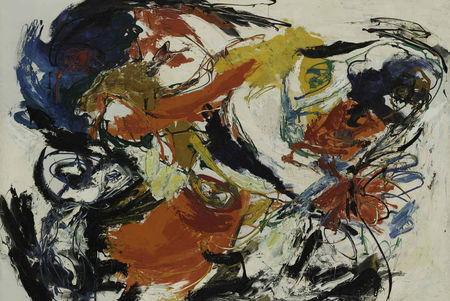Sotheby's to Sell "The Former Peter Stuyvesant Collection"
Tony" by Niki de Saint-Phalle, executed in 1965. Estimate: €250,000 - 350,000. Photo: Sotheby's
AMSTERDAM.- Sotheby’s announced that it will offer for sale 163 works from the former Peter Stuyvesant Collection, property of British American Tobacco Netherlands (BAT), on Monday, March 8, 2010 at Sotheby’s in Amsterdam. The works from the collection to be offered for sale are estimated to realise in excess of €.4 million.
The collection is the largest collection of Post War and Contemporary Art ever to come at auction in the Netherlands. Starting in the late 1950s it became famous as the Peter Stuyvesant Collection and now consists of more than 1000 works created by artists from over 40 countries. The core body of the collection, which will be offered for sale in March, comprises 163 works by leading artists such as Karel Appel, Arman, Alighiero Boetti, Corneille, Alan Davie, Simon Hantai, Mike Kelley, Martin Kippenberger, Per Kirkeby, Wilfredo Lam, Robert Mangold, Robert S. Matta, Kenneth Noland, Roman Opalka, Niki de St Phalle, Serge Poliakoff, Manuel Rivera, David Salle, Giuseppe Santomaso, Jan Schoonhoven, Jesus Rafael Soto, Gunther Uecker and Victor Vaserely. All these artworks are completely fresh to the market.
The story behind how this remarkable collection was formed is inspiring: in the late-50s Alexander Orlow, the Managing Director of Turmac Tobacco, put his love for abstract art to industrial use. “However complicated the operations of a machine may look,” he said “it soon becomes monotonous to factory worker”. He wanted to improve their working environment, raise the spirits of his dedicated employees, he decided to and did this by building year by year what in time became a world-class collection of large, colourful contemporary works specifically chosen to be shown in the factories above the machinery and so provide inspiration and stimulation.
As Dr. Wim Beeren one of the advisers to the collection wrote: "Alexander Orlow came up with the sublime idea to place paintings by modern artists in the factories surrounded by the industrial process. It demonstrated the great faith that Orlow had in the works of art to create a stimulating environment within the work process.”
The History of the Collection
The Peter Stuyvesant Collection started as a daring experiment with art in the production company in Zevenaar in the Netherlands, in the late-1950s. Alexander Orlow, then Managing Director of Turmac Tobacco Company in the Netherlands, was the inspiration behind the formation of the collection.
In 1960 Orlow invited 13 artists from various European countries to create paintings for the production halls, the theme being “Joie de vivre”. Each painting would have to be large in size with vivid colours and shapes powerful enough to stand out in the large noisy factory halls. For many of the artists this application of art was a completely new experience. Employees too, were caught unaware by this artistic adventure when the paintings were installed at night as a surprise. The initial response of the majority of employees was disbelief. After six months, the employees even expressed a preference for the abstract works. This was the start of the Peter Stuyvesant Collection.
By 1961 it became clear that there needed to be a guiding hand in the selection of what should be added to the collection. Orlow appointed a succession of highly respected advisors out of the museum world and gave them all a simple brief and a free hand. The criteria for the collection were that
• the works should be large in scale,
• bold in imagery,
• by artists of international standing.
The first adviser appointed was Willem Sandberg, former Director of the Stedelijk Museum in Amsterdam; then Renilde Hammacher van den Brande, former chief curator for modern art at Museum Boymans van Beuningen in Rotterdam; followed by Wim Beeren, former Director of the Stedelijk Museum in Amsterdam; and most recently Martijn Sanders, former Director of the Amsterdam Concertgebouw (until 2006).
Over the last 50 years years, the collection has expanded and gained worldwide critical acclaim thanks to the help of these top-class advisors, becoming a highly quality varied and international collection of art that represents artists from Europe, the United States, China, Russia, Brazil and South Africa.
Initially the emphasis was on the Cobra painters Karel Appel, Constant, Lucebert and Corneille, as well as other artists such as Alechinsky, Brands, Saura, Poliakoff, Manessier, Matta and other expressionists active in the 50s and 60s. Later the collection was expanded to include representatives from such movements as Analytical Art, Nouveau Réalisme, Arte Povera, the American color field painters and later movements such as the Neue Wilden.
Karel Appel, "Tête Tragique", signed and dated 61. Oil on canvas, 229.5 by 299.5 cm. Est: 120,000 - 180,000 EUR. Photo: Sotheby's.

/https%3A%2F%2Fprofilepics.canalblog.com%2Fprofilepics%2F1%2F0%2F100183.jpg)
/https%3A%2F%2Fstorage.canalblog.com%2F03%2F02%2F119589%2F96711876_o.jpg)
/https%3A%2F%2Fstorage.canalblog.com%2F11%2F31%2F119589%2F94773502_o.jpg)
/https%3A%2F%2Fstorage.canalblog.com%2F20%2F83%2F119589%2F94772815_o.jpg)
/https%3A%2F%2Fstorage.canalblog.com%2F26%2F72%2F119589%2F75604929_o.jpg)
/https%3A%2F%2Fstorage.canalblog.com%2F59%2F60%2F119589%2F26458628_o.jpg)




/http%3A%2F%2Fstorage.canalblog.com%2F46%2F13%2F119589%2F126868716_o.jpg)
/http%3A%2F%2Fstorage.canalblog.com%2F15%2F12%2F119589%2F96191999_o.jpg)
/http%3A%2F%2Fstorage.canalblog.com%2F02%2F05%2F119589%2F32528116_o.jpg)
/http%3A%2F%2Fstorage.canalblog.com%2F74%2F57%2F119589%2F32152192_o.jpg)